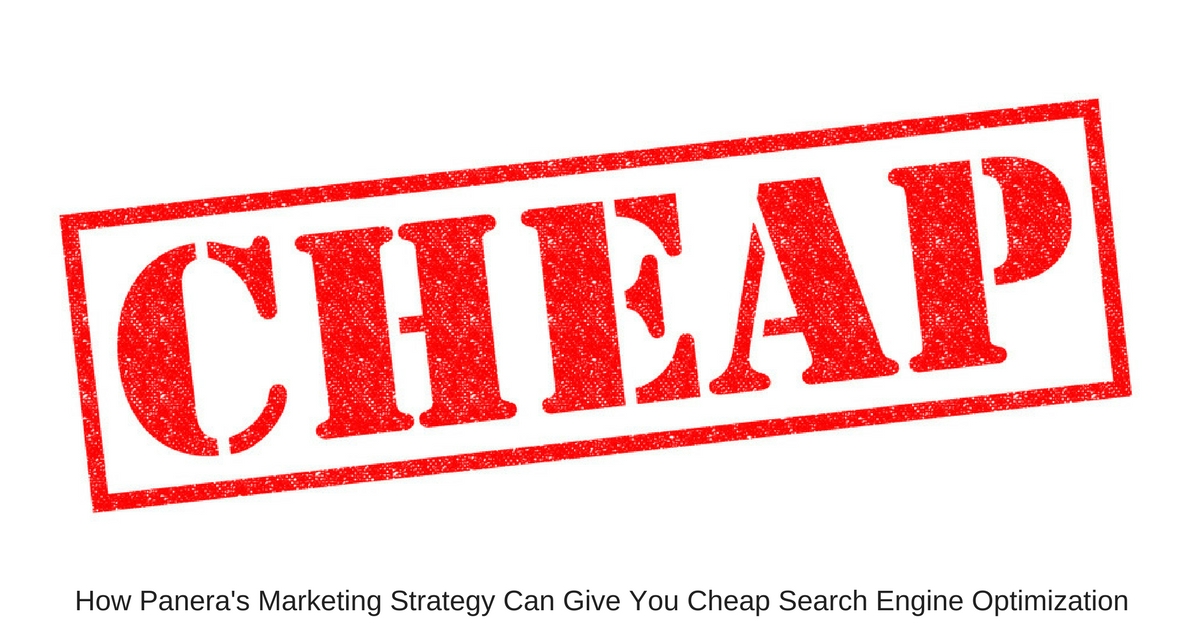A while back, Gabe wrote a piece about Panera’s one-dollar profit booster. After the cashier took his order, he was asked if he would like to add a pastry for a dollar. Simple— yet profound.
Gabe calculated that Panera could have made upward of $81,000 in net profit each day if only 30 percent of an estimated 200 customers a day said yes to that sweet treat. Yearly, this Panera marketing strategy could have brought in millions of dollars in profit!
Now, this has great implications for your business — and your search engine optimization. Panera’s strategy is a cheap, quick, and easy way to do a few things:
- Bring in additional profit
- Encourage customers to try a new or different product at a reduced price
- Give the customer a deal on the normally higher-priced pastries
- Create greater customer loyalty as they appreciate the discounted pastry price
The optimized their sales strategy to make the most of all of their resources: friendly employees, an expansive menus, and hungry customers. While we can learn from that for our sales and marketing plans, we can also implement this one-dollar trick to achieve cheap search engine optimization.
Take an SEO Inventory
What do you have that your customers appreciate? What can you use to help them grow their business? Look at the different components of a successful SEO strategy.
On-page resources
Content marketing rules in on-page SEO. This includes the standing copy on each of your Web pages as well as the words and images you use in your blog.
Off-page resources
Off-page SEO is just what it sounds like: boosting your search engine ranking by doing things not directly on your Web site. These include link building, social media, social bookmarking, and building up your reputation.
Technical SEO
While technical components tend to be the least of the cheap search engine optimization techniques, they are still valuable parts. There are many behind-the-scenes aspects of technical SEO, but all are centered around providing the user with a better experience. Google’s list of ranking criteria has shown that they have a preference for creative and efficient design that keeps the user in mind.
Now, run through each list to see what you have at your disposal.
- Do you have a blog? Are you keeping it updated?
- Do you incorporate compelling graphics?
- Are you active on at least one social media platform?
- Are you receiving pingbacks on people sharing your links in their own blog posts?
- Have you seen an influx of traffic from reputable Web sites?
- Has your Web site been mobile-optimized?
- Is your Web design clean and easy to follow?
If you’ve answered no to any of these questions, it’s time to pull in Panera’s one-dollar trick.
The Question You Need to Ask Yourself and How Panera’s Tactic Can Help
Panera’s employees didn’t care whether you bought a coffee or five full breakfasts. Everyone got the same question: would you like to add a pastry for a dollar? Note the language. They didn’t make mention of the lower price, the words buy or sell. The question was upbeat, with a positive feel, since they were adding to and enhancing the purchase you already made by adding something sweet.
Now, your SEO isn’t asking your customers and visitors to give you money. It is, however, selling. You’re selling yourself to anyone who visits your site, which is why Google is ranking high-quality, user-focused Web sites much higher than those who aren’t following their preferences.
Panera isn’t leaving anything on the table. Whether their customers are on a diet, being frugal, or just focused on something else, people can find it easy to leave behind the full-priced version. Panera, though, is known for their delicious baked goods. This one question removes the barriers and excuses their customers are putting up.
Now, think about the barriers your prospective Web site visitors are putting up — and pull in Panera’s tactic to bring them to your Web site. Make sure each encounter they have with you, on any platform, makes them ask themselves one question — do I want to get to know this company even better right now?
Now, you don’t have to come out and use those words. You should, though, find the right words that will entice your readers to take the step to click on your Web page in their search engine results page.
Cheap Search Engine Optimization Tips
Panera didn’t put restrictions on the pastries in that specific marketing strategy. They didn’t say, would you like to add a cookie, a muffin, or a Danish, for a dollar. They made all of their pastries available to the customers and easy for the to access. Most of their customers can, and will, spare a dollar, especially with the smell of the baked goods sitting right next to the cashier wafting over the counter.
SEO can seem like a lengthy, expensive process, but it doesn’t have to be that way. When you consider that search engine optimization runs on content marketing, you’ll see that shifting your perspective on content marketing improves your search engine results. When you make a concerted effort to focus your content on meeting the needs of current and prospective customers and Web visitors, you’ll see a bigger return.
The good thing is, like Panera, it doesn’t mean you have to make excessive investments of time and money to do so. Panera was already baking the pastries; you’re already (hopefully) taking steps to engage and interact with your customers.
Just as Panera was able to grow their sales by calling attention to and removing barriers to purchasing their pastries, you can grow your search engine results by using these cheap search engine optimization tools to see greater results.
Check your Content
Since content is, and will be, a major player in search engine optimization, your first step should be to audit the content on your Web site. It can be a time-consuming process — but one that is very worth your while. You’ll look through all the content that can be indexed, and compare it to a set of metrics that will help you meet the needs of your customers and the search engine’s requirements. Looking for an extensive list? Check out Content Marketing Institute’s nine best analytics that will help with content audits.You’ll be looking for overlapping content, up-to-date and relevant content, current statistics and facts, keyword enhanced articles, page errors, and broken links. Check out each page, make notes of the analytics you’re consistently seeing from the pages, and then make your updates. Keep tracking the numbers you’re seeing to gauge the effects of your changes.
Meet the Needs of Mobile Users
A few years ago, Google made it abundantly clear that they prefer mobile-friendly Web sites. Their Mobile-Friendly Test not only shows you how well your Web site performs on a mobile device, but also shows you where your site is not performing well. If you don’t want to use their services, check your site yourself. Borrow a few different smartphones and tablets and open your Web site. Open each page, rotate the screens, see how the layout looks, time the page load speeds, and make sure buttons are large enough to tap for fingers of all sizes. When you’re scrolling and doing your own shopping, take note of the sites you like and the ones that seem to make shopping inconvenient and challenging — and make sure your site incorporates the good and eliminates the barriers that will keep your visitors from adding on a visit to your main page.
Look at Your Load Times
While many pros will say that Web users have between one and four seconds for the page load speeds, a five-year-old study begs to differ. Google engineers discovered that in the blink of an eye, users will shy away from a page. Their research shows that people are less likely to visit a Web site if it’s slower than a competitor’s by more than 250 milliseconds. Remember, a millisecond equals one-thousandth of a second –so this means if your site takes longer than a quarter of a second to load, you could be missing out on valuable visitors, and leaving page visits on the counter.
Call on Keywords
You’ve probably heard about keywords, and maybe you’ve tried incorporating some into your content, but this is a good time to learn more about the best way to use them. These are the words that your prospective visitors are searching when they hop on a search engine. These are also the words that will increase your organic traffic. Look at your list of keywords to make sure they’re still relevant for your business. Do some research to see how they rank and the amount of traffic they are generating. Read through the content to make sure they don’t stand out unnaturally. Make sure they’re included in your headline, body copy, subheads, and URLS, but don’t use too many.
Create Compelling Calls to Action
Like the often overlooked oatmeal raisin cookie, a the call to action can be an overlooked game-changer. Every page on your Web site, every post on social media, and every piece of content you publish needs a call to action. This makes conversions easy for your visitors, since they won’t have to spend time trying to figure out exactly what you want them to do. It helps you focus your content and draw attention to your products, and the efficacy is easily demonstrated through A/B testing. As you watch the results and analytics from your testing and calls to action, you’ll see what your customers prefer.
Scout out Social Media
Looking for a cheap search engine optimization tactic? Social media platforms are high on the list. Whether you join the leaders, like Facebook and Twitter, the photography-focused sites like Instagram and Snapchat, a platform for professionals, like LinkedIn, or one of the many others, you’ll find a place with plenty of potential for growth — if you use the platform wisely. Get to know the demographics of your target audience, find out the social media platforms they prefer, and stay active and engaged. Make sure you’re regularly updating your account, responding to customer messages and comments, and verifying that links all work.
Step up Security
Google is placing a higher priority on site security, with Chrome labels for sites that are not providing a secure HTTPS connection. Look into getting a secure sockets layer (SSL) or transport layer security (TSL) certificate, which encrypts information entered by customers, breaking down the barriers that might keep some from completing purchases. As time progresses, many experts are predicting negative feedback and ranking for sites that haven’t made an effort to become more secure.
Pull Out Panera’s Plan
It seems almost too simple. These are some of the most important parts of SEO, displayed for all to see— and overlooked by businesses owners and marketers who are in a hurry and pulled in different directions. Just like Panera’s cashiers, who didn’t just wait for a customer to ask, but made sure to point out their pastries to their busy, rushed customers, your can’t leave your SEO strategy to the chance that things will all work out.
Reviewing and repairing these cheap search engine optimization components can lead to higher levels of engagements, a better reputation, and, ultimately, a higher ranking on the search engine results page. Not sure where to start? Let us be your Panera cashier. Right now, we’re offering a free SEO analysis. Our experts will take a look at each of the pieces you’re employing right now to boost your ratings, and will not only make suggestions for improvement, but will help you see which resources you’re under-utilizing.
Give us a call today — don’t leave your search engine optimization laying on the counter. And, for fun, what’s your favorite Panera pastry or product? Leave a line in the comments! Mine? Butternut squash soup — but French toast bagels are a close second.
Oops! We could not locate your form.







